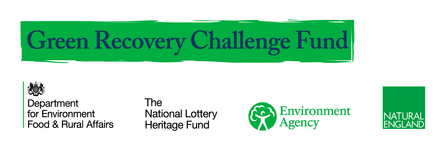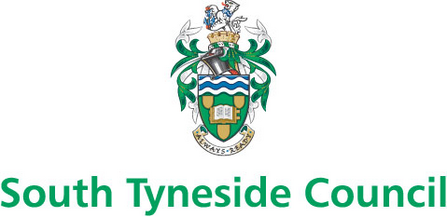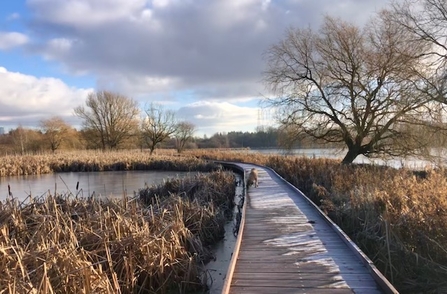
Photo by Rachel Richards
Photo by Denis Howarth

Photo by Rachel Richards
This week the North east of England has had it all; heavy frost, heavy snow, heavy rain, but also, a little bit of sunshine. I don’t know about you, but now, more than ever, when the sun shines I get out and soak in the sights, sounds and colours of nature.
The Healing Nature project is funded by the Green Recovery Fund and runs in partnership with local councils, working on 20 local Wildlife Sites in Gateshead, Sunderland and South Tyneside. My role is to organise lots of exciting and varied public engagement events, but before I can do that I need to get to know the sites. This Monday when the sun shone, before the snow and rain hit I was lucky enough to get out for a walk on a couple of the Gateshead sites. We have some wonderful green spaces on our doorstep and I am very much looking forward to meeting more of the local people who enjoy and care for these spaces.
My day began at Shibdon pond, west meadow, Blaydon. I walked across the board walk in glorious sunshine and a heavy frost listening to the calls of Canada geese, swans and gulls, that were breaking the ice to bathe. I chatted with local bird watchers about how black cap and chiffchaff, once only visiting the UK in summer months, now winter here in Gateshead and how grasshopper warblers are often heard here in the summer months. Moving into the woodland, blue tits, great tits, coal tits, robin, bullfinch, and a party of long tailed tits entertained me as they flittered through the trees, calling as they did along with a few passing redwings. I then stopped to watch a goldcrest, our smallest breeding bird with a glorious golden crest, picking its way through a pine tree, foraging for insects, oblivious to me.
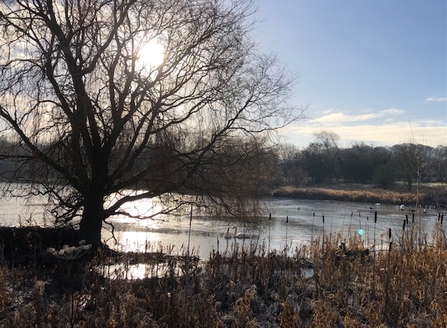
Photo by Rachel Richards
Further along a wooded path I spotted what I often call a marsh-willow tit. If you have done much bird watching you will understand the difficulty. The marsh tit and the willow tit are two almost identical looking birds, thought to be just one species until 1897, both of which are Red listed species that we are lucky enough to have in the North east of England.
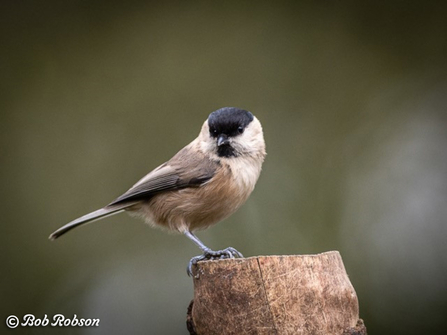
Willow tit
Photo by Bob Robson
When these birds call it is much easier to tell them apart. The willow tit has a very rough call, as though it’s shouting at you, whereas the marsh tit's voice is more of a nasal sneeze, which is nicer than it sounds. I watched for a while, taking notes on the various subtle features which can help distinguish between the two, recording the call on my phone for later internet browsing. I later learned that the 4-5 note call was in fact the song of a willow tit, a beautiful, yet simple, early sign of spring. I find it reassuring, that in nature life goes on, even when ours can feel like it’s on hold. Taking time to watch nature, connect with it, observe and feel the changing seasons can be very grounding and a healthy distraction from the stresses of life.
One of the reasons why willow tits are declining is that unlike many hole-nesting birds, including the marsh tit, they like to make their own nest hole and not reuse them. This, therefore, requires digging out old, dead, rotten wood for their nest site and this habitat is often lacking. On sites like this the retention of standing dead wood as part of site management is very important so gathering information from locals about what they observe is essential.
Driving south I moved on to Chopwell East Fields where I enjoyed the afternoon sun across a wet tussocky meadow. Dead seed heads of knapweed and yarrow in the dryer meadows provided a reminder of the flowers which will return with their colour in the summer months. Here among rushes I flushed a snipe away, which called crossly as it zig-zagged low over the field to hide again in a far corner. I also glimpsed a woodcock, similar to a large snipe, both birds with long beaks which they use to probe into wet ground for worms and other invertebrates.
In a nearby silver birch, with its catkins beginning to extend, a small group of noisy finches foraged unperturbed by passing dog walkers. Not a goldfinch. The call was wrong, so what could they be? Picking up my binoculars I saw red around the head and breast and black at the base of the beak, which I identified as the elusive redpoll. These beautiful little finches hung upside down pulling seeds from the silver birch and alder, working quickly and noisily, then flying on to the next tree.
As I walk around a site I am imaging in it spring and summer, flowers blooming, the bees and butterflies buzzing, skylarks singing and I am very much looking forward to enjoying all these things with school children, local dog walkers and anyone, who like us, appreciates the countryside and the wildlife on our doorstep.
Now, more than ever, COVID has shown us the value of our green spaces for our health and wellbeing, both physical and mental. Many have decided to learn more and to give back to nature. If you would like to learn about this project please do visit our project overview view and if you live near any of the sites we are working on, please get in touch and get involved. We look forward to meeting you! :)
Healing Nature is a Green Recovery Challenge Fund and Partner funded project.
